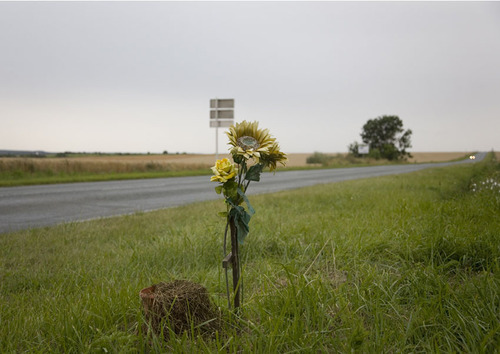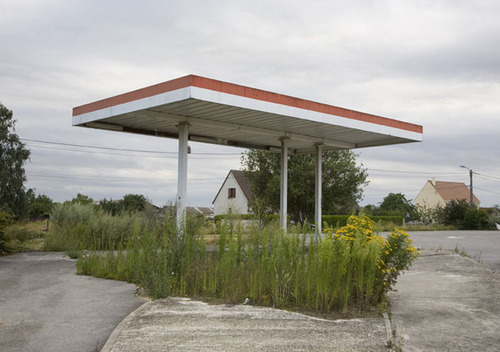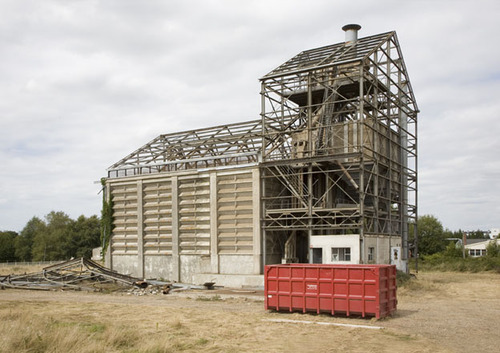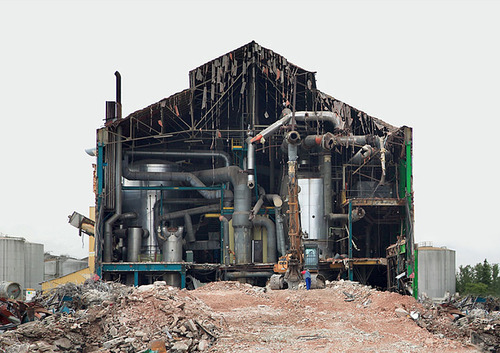You mention that you studied sociology. In which way do you think these studies influenced your photography? Don’t you find it somewhat strange that a sociologist completely avoids people in his works?
Eric Tabuchi (ET): Through sociology I discovered the work of Augustus Sanders and the photographers of the “New Objectivity”, particularly the Becher and Lewis Baltz. At that moment, it appeared to me that showing the infinite diversity of what men build was a good way to describe the men themselves, with the particular distance that belongs to sociology. Each building or object that I photograph - they are always very humble in nature - is in my view a counter-field of the humanity as such. I always try to photograph the “things” as they “are” because it seems to me that the sense of the landscape environment described those who live there very well.

© Eric Tabuchi from the series 'Mobile Home'
Being born from Japanese father and Danish mother, and living in Paris, how did you get in touch and love with American photography? Tell me more about your photographic and artistic growth path.
ET: With hindsight, and to be very honest, the influence of American culture on exercising my imagination is probably due -precisely- to my lack of imagination.By this I mean that the enormous power of American art, be it literature, cinema, music, art or even propaganda made it difficult in the 70s not to be undergoing this force of attraction. Having said that, I first “entered” in American photography with Lee Friedlander, especially the pictures of the roadside. I think at that time I was a lonely young man and I identified with this melancholic universe, which was reminiscent of Hopper’s paintings. However, the real turning point, the one that really drew me into photography is the discovery of the work of Lewis Baltz. His thoroughness, the silence of the suspended world, which he described in “Park City” for example. Parallel to this, and in a much more “lighter” spirit, I’m passionate for Californian artists using photography like Douglas Huebler, John Baldessari, Ed Ruscha and many others. For completeness, the way Robert Smithson used photography to document his work has also played an important role in that it realized the connection between the “pure” photography of Baltz and the conceptual approach of the “Californians”. In fact, my relationship to photography is the result of the blending between this objective rigor and pop flippancy.

© Eric Tabuchi from the series 'Monuments'
Have you ever been in America? Which country do you love the most: France or America?
ET: I went shortly twice, in New York and Los Angeles, that’s just to say that I haven’t traveled in the United States. As I hinted in the previous question, my fascination for America dried up over time to the point that today I no longer feel attraction for this country. If my eyes had to go elsewhere it would be much more to Europe or Central Asia, on the other side of the Atlantic. Anyway, when I started taking photos there, it was soon clear in my mind that I will not do those images of France just because I was somehow indifferent. I refuse still now to take pictures outside my familiar territory. I’m often saying something that is certainly not appealing to everyone but I have some difficulty with images taken in spectacular places of the planet and returned, as if we were still in the nineteenth century, to be exhibited in galleries or museums. So yes, definitely, I prefer photographing France.

© Eric Tabuchi form the series 'Eldorado'
As you have confirmed, your works are also clearly influenced by the Becher’s series. What is your intent in creating series? Is it a mode to classify reality? Or a way to document and save things from oblivion? Or is it rather a method to strengthen the message you want to communicate by using repetition? Please highlight the mindset behind this language choice.
ET: The ambition of bringing together the totality in a serial work has always fascinated me because of course it is a mirage: the more we have the feeling of approaching a very readable and coherent sense of it, the more indeed it moves away. In this sense the work of the Bechers is absolutely exemplary. What makes this work so compelling is, in my opinion, the absolute failure of their ambitious intent because, in the end, what we absorb from their photographs is that they consist of pure forms, interlacing materials that with the force of precision and obstinacy become abstract design and,sculpture. For me the photographic series constitute the beginning of a research doomed to failure, an attitude that has much more of the pathological rather than of the rational, even if it uses the objective argument for concealing this truth. For a long time, because I owned nothing, I thought I could not be a collector. It is only relatively recently - after the death of my father - that I deeply realized that I was so non materialistic because all my work is reduced to a few megabytes on a hard drive, so after all it is the same.

© Eric Tabuchi from the series 'French Countryside Skateparks'
It is often said that the use of black-and-white contributes in highlighting forms, volumes and graphics more than color does. How important is color in your photography? Which value does it add to the message and atmosphere you produce?
ET: My visual culture comes for a large part from the Painting, but also from advertising - I quickly found that I saw the world as I dreamed it, that is with colors. Certainly there was more in my choice of color, a desire to not to place myself in the great tradition of black and white. Today I put a little black and white and mostly gray in my colors. To be even clearer, I’m saying I’ve never much appreciated black and white, and after some time, namely since I searched on the Internet in the attic of photography, that is true for all photographs.

© Eric Tabuchi from the series ''Roadside Flowers'
You prefer to think of yourself as an artist rather than a photographer. Do you make or plan the use other media or artistic languages beside photography?
ET: It’s not just that. I do not define myself as entirely belonging to the photography side because, indeed, I use other media, including sculpture. But, and this is important, I make no hierarchies between these different practices, and often find quite absurd the distinction between being a “photographer” or an “artist”. Regarding the future, I began working on hybrids of photo and video, more precisely on the idea of the projection of static images but with the potential that video gives today.

© Eric Tabuchi form the series '26 Abandoned Gasoline Stations'
In some works you make use of images coming from Google Earth and Street View. Do you think this might reinforce your attitude of distance and neutrality leading it to extremes?
ET: Internet recently, has become a second world, a sort of replica through which we have condensed the notion of distance. Beijing, Moscow and Lima are equidistant in the virtual space. With new means of transport like Google Earth and Street View we can be “tele-transported” with one click from one point to almost any other in this parallel dimension that is the Web. Being capable of exploring this huge library is a significant innovation and I would find the idea very strange that a great curiosity would not grow for this new “world”. Whatever opinion one may have with respect to this company, over the last ten years Google has realized that in terms of storage and construction and finally conquered our planet. No man, no army, no civilization has ever realized even a tenth of this and I believe artists should concern themselves with this unparalleled change in history.

© Eric Tabuchi form the series 'Eldorado'
Could these new digital worlds, born from a systematic and objective sampling of reality, constitute by contrast a new field of subjective expression for a modern artist? Is it worth re-exploring what was already “fixed” by someone else’s eye?
ET: I don’t know if a world viewed from three meters in height, in which all the faces are blurred and where the route is ultimately the only horizon, can seen as an objective representation. It is true that by assembling the infinite number of available images differently from Google the photographer or artist can for example make the information hidden inside the monotonous or anecdotal flow of Street View become more accessible.

© Eric Tabuchi form the series 'Eldorado'
Can you explain the meaning of the “Memory Machine/notes” work section in your site?
ET: Initially the idea was to have a kind of notebook in which I would have noted the different sources, references or documents which inspired my work but after several months this section took such importance that I decided to do a parallel site dedicated to archiving images from all origins. For this reason I removed the “Memory Machine” from my site.
I saw some photo-documentation of your exhibitions. Most of them have quite original and interesting settings. Very beautiful indeed. Do you arrange them by yourself? How important is the exhibition phase and how much time do you invest on it?
ET: Yes, this point is very important to me. For my works exhibitions are a bit like reconstructing a landscape with elements collected during the real shooting. An exhibition does not consist so much in showing singular images as these produce only other images that would then be exhibited as a meta-construction. I have much pleasure in doing so that the exhibition (modestly) “remakes the world” as we say in French. It seems to me that too many photographers consider the space of the gallery or museum as a simple surface on which to hang their photographs, this could be great but it can also be interesting to consider the space and not only the surface as essential.
---
LINKS
Eric Tabuchi
France
share this page